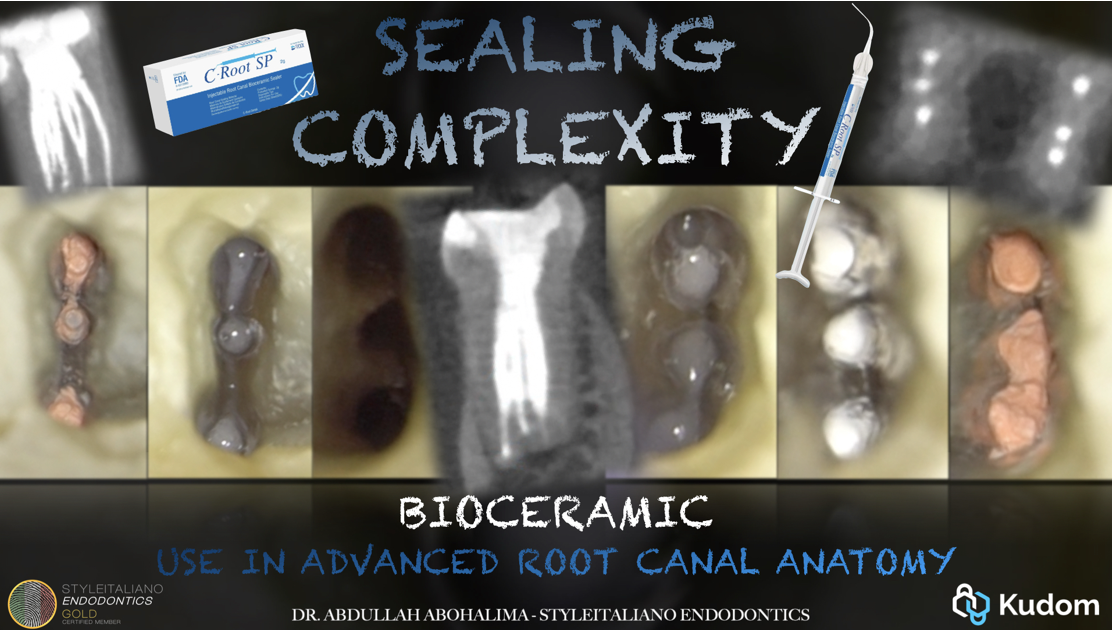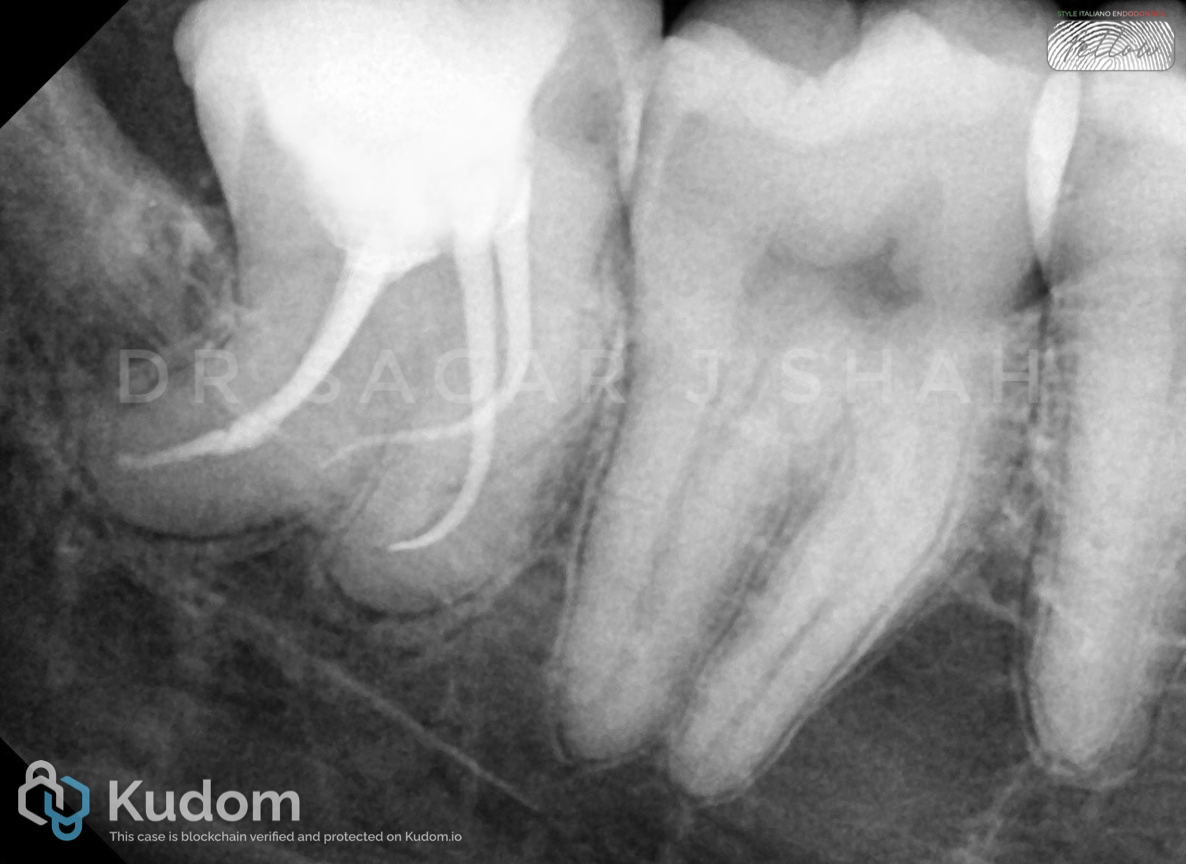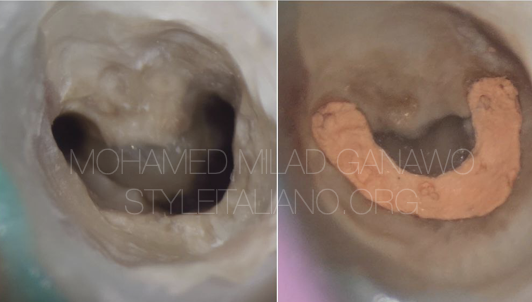The c-shaped canal is an antomical variation that was first reported by Cooke & Cox in 1979 and mostly seed in mandibular molars, although it can occur also in mandibular premolars and maxillary molars
 C-shaped molars
C-shaped molars
The c-shaped canal is an antomical variation that was first reported by Cooke & Cox in 1979 and mostly seed in mandibular molars, although it can occur also in mandibular premolars and maxillary molars
 Detection and Management of a Missed Middle Mesial Canal: CBCT and Operating Microscope-Guided Retreatment. A Case Report
Detection and Management of a Missed Middle Mesial Canal: CBCT and Operating Microscope-Guided Retreatment. A Case Report
Mandibular molar retreatment due to an missed middle mesial canal. CBCT and Operanting Microscope are essential to identify the etiology and achieve three-dimensional disinfection. A Case Report
 SEALING COMPLEXITY. Bioceramic use in Advanced Root Canal Anatomy. A true Middle Mesial & Middle Distal Canals Management!.
SEALING COMPLEXITY. Bioceramic use in Advanced Root Canal Anatomy. A true Middle Mesial & Middle Distal Canals Management!.
Variations in root canal anatomy, particularly the presence of middle mesial and middle distal canals, pose a significant clinical challenge.
Complex canal anatomies demand advanced strategies for effective cleaning, shaping, and obturation.
This article demonstrates how meticulous canal exploration, enhanced disinfection protocols, and bioceramic-based obturation can successfully manage such complexities, achieving a predictable three-dimensional seal.
 The extra root
The extra root
In endodontics, the terms "radix entomolaris" and "paramolaris" refer to specific anatomical variations of the roots of molar teeth, particularly in relation to their root canal systems. Identifying a radix […]
 Endodontic Retreatment of a Bifurcated Mandibular Second Premolar with 12-Month Follow-up
Endodontic Retreatment of a Bifurcated Mandibular Second Premolar with 12-Month Follow-up
A case of successful retreatment of a mandibular second premolar (FDI: 35) with chronic apical periodontitis, caused by a missed lingual canal (Vertucci Type IV bifurcation). Utilizing a dental operating […]
 THE CURVE CONUNDRUM: ENDODONTIC MANAGEMENT OF A DILACERATED THIRD MOLAR
THE CURVE CONUNDRUM: ENDODONTIC MANAGEMENT OF A DILACERATED THIRD MOLAR
Dilacerated roots pose endodontic challenges; careful imaging, flexible instruments, and meticulous technique ensure predictable treatment outcomes.
 Respecting the curves with Rising
Respecting the curves with Rising
Endodontic success relies heavily on the ability to shape root canal systems with precision, minimal risk, and maximum conservation of original anatomy. Among modern instruments, the Rising endodontic files by […]
 Single-Visit Management of a Dens Invaginatus Case
Single-Visit Management of a Dens Invaginatus Case
Dens invaginatus, also referred to as dens in dente, is a rare developmental dental anomaly resulting from an infolding of the enamel organ into the dental papilla during the morphodifferentiation […]
 Retreatment of a Mandibular Second Molar with a Periapical Lesion in a C-Shaped Canal
Retreatment of a Mandibular Second Molar with a Periapical Lesion in a C-Shaped Canal
Endodontic retreatment of a mandibular second molar with a C-shaped canal configuration presents unique clinical challenges due to its complex and variable anatomy. C-shaped canals, are commonly found in mandibular […]
 Maximizing the Efficacy of Sodium Hypochlorite in Endodontic Disinfection: A Clinical Overview
Maximizing the Efficacy of Sodium Hypochlorite in Endodontic Disinfection: A Clinical Overview
Enhancing NaOCl efficacy in endodontics through exposure time, activation techniques, concentration, and temperature for optimal disinfection.
 Coalescence Phenomena of MB2 Canal
Coalescence Phenomena of MB2 Canal
The Presence of Second Mesio-buccal canal in Upper Molars is One of the most common scenarios of Anatomical Variations. According to Studies from Different Middle Eastern Countries, The prevalence of […]
 UL6 with unusual anatomy
UL6 with unusual anatomy
The incidence of MB2 and MB3 in upper first molars is low (Ronald Ordinola-Zapata et al., 2020), however one of the most common reasons for endodontic failures is missed anatomy […]